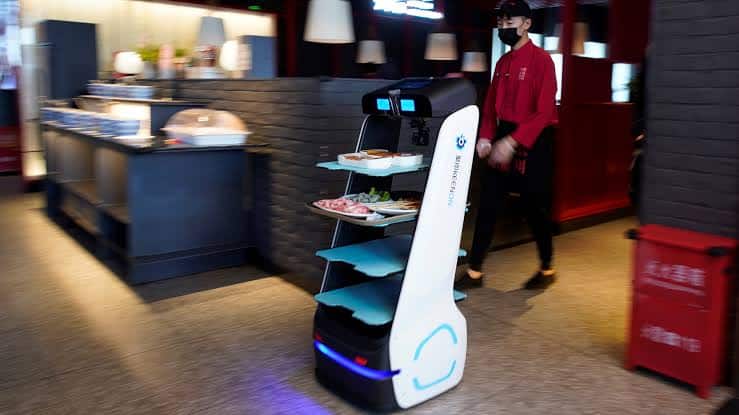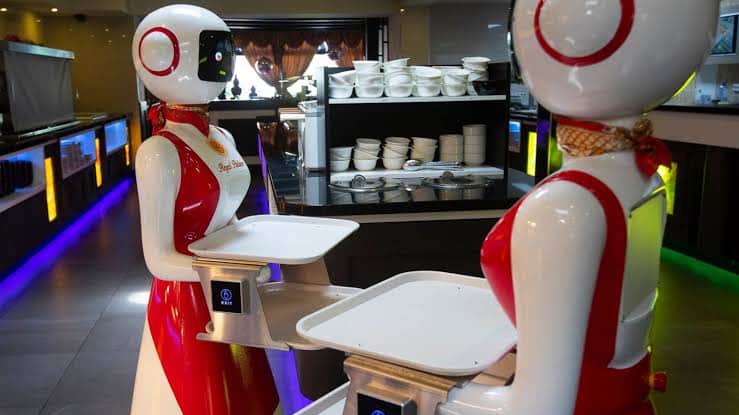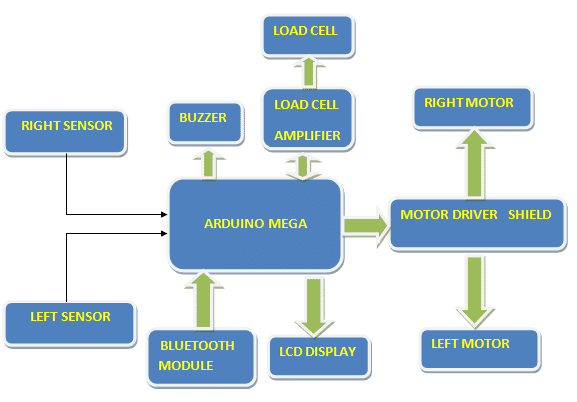
Robots are here to stay in our lives. And it’s no surprise: they combine technology that makes human life easier and, most importantly, saves us time and effort.
What is the definition of a robot waiter? Its aim is to serve as an interactive assistant in the order process, bringing and collecting food and drink, and interacting with restaurant patrons. They’ve been around for a long time in China and are now becoming more well known in the rest of the world.
We’ve shared news about robots that prepare hamburgers or even a chef with our readers, but we’ve virtually always been to Japan or the United States to discuss these clever technologies.
This week, we discuss the robot waiters that are already being spotted in some of the country’s restaurants. We met Jefito, the first robot waiter in Zaragoza, just a few days ago in a restaurant where he serves dishes and tells jokes in turn.
Amazonia Chic has two of these gadgets in their restaurants, one in La Vaguada and the other in Plenilunio. Peanut is the first of these, and a member of the 20Bits team went to meet it in person.
Ultrasound sensors are included to help overcome obstructions.
Penaut (Penaut), a Keenon T1 robot, has a huge interactive Artificial Intelligence (AI) engine that allows you to customise a series of bionic expression packages that allow you to convey emotions comparable to human ones such as happiness, rage, despair, and so on, via an LED panel.
As a result, communication or interaction with the client becomes more exciting. According to Amazonia Chic, Peanut, in fact, has to be caressed by the client before leaving to conduct another chore.

It also has ultrasonic sensors to help you overcome barriers and avoid colliding with anything or anyone at any time.
Although we see it during restaurant service, it is more commonly found in dining services, pubs, restaurants, and hotels. Its job is to transport and collect dishes, such as plates, coffee cups, and glasses, as well as drinks and food, from one location to another. The goal, according to Lin, the person in charge of Amazonia Chic, is to speed up service tasks.
It comes in a variety of colours and can weigh up to 30 kilogrammes. It costs roughly 15,000 euros, according to RobotShop, although it’s also available on Aliexpress.
It is thanks to the Chinese restaurant firm Shangri-La, which received the first permission in Europe to send a robot waiter to Spain roughly three years ago. There were three in total, two of which were operating in these eateries.
This robot that we encountered transports food from the kitchen to the table and subsequently picks up the dirty dishes, assisting the service in these more mechanical tasks and seamlessly integrating its function with that of the rest of the room team, allowing the employees to be more productive. As a result, waiters focus their attention on improving customer service while consumers appreciate the speed with which orders are delivered, thanks to robots.
Operation Peanut
Lin revealed to us that behind Peanut is a screen, such as a tablet, on which the table assignments are displayed, and he goes to the appropriate table. “It helps the waiters a lot,” he said, “but it still needs backup from the crew,” because Peanut can be wrong if a table is moved.
When Peanut comes to the table, he uses a pre-recorded remark to inform the diner that he is bringing his food. The robot can move to another table or return to the kitchen area to receive additional dishes after leaving the food.
Lin told us that some customers are surprised to see him and that others come to the restaurant specifically to see him, which makes him a fantastic marketing claim for the restaurant, which offers a unique experience.
The robot is led by sensors on the roof that indicate its course as well as where it should stop and recharge. It has a battery that lasts roughly a hundred hours on standby and eight hours in operation, and it senses when the battery is becoming low and only goes to the charging area.

“It draws a lot of clients, especially youngsters, and in general, people appreciate it,” adds Lin, who also assures us that this type of robot will not replace people in their duties but that it will simplify and minimise the work of servers.
Waiters who are robots
The Pudu robot waiter is made up of two different systems: one with an isothermal chamber (Pudubox) and the other with open shelves (PuduBot). Both robots are intended to provide material or food collection and delivery services.
It can be fully charged in about four hours and can collaborate with other robots.
Bear Robotics’ robot Servi transports dishes and meals, and once the consumer has gotten everything, all you have to do is press a button to have Servi retire.
Amy or Alice greets individuals, walks with them, provides information and consultation, educational help, and even care and accompaniment at home, among other things.
It’s a robot waiter who can accept orders and deliver them to a bar or restaurant. However, it can also be a fantastic option for providing information at fairs or just at the event’s entrance.
The G2 Robot Guide by Keenon is a commercial guide robot that can work in interior locations like restaurants, hotels, supermarkets, movies, commercial offices, and other public venues.
It has a high-resolution screen on both sides, which provides the user with visual information. It can deliver information in a variety of languages and can also be used for surveillance in closed environments because it can load automatically when needed.
The Haidilao Hot Pot, part of China’s largest restaurant chain, is already home to the world’s first fully robotic restaurant, complete with waiters and chefs.
